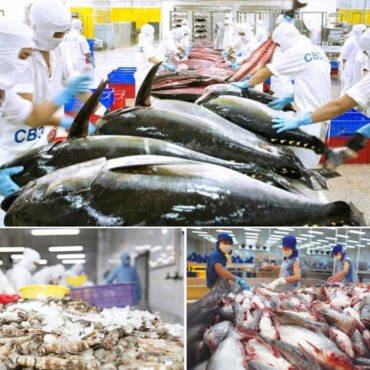Not only rising and maintaining the world’s number 2 position in rice exports, many other Vietnamese agricultural and aquatic products also won big when export turnover increased sharply, agricultural product prices were high, and farmers and businesses both benefited.
That is the information given by many businesses and industry associations at the conference to promote agricultural, forestry and fishery exports in 2025, organized by the Ministry of Agriculture and Environment in Ho Chi Minh City on August 12.
However, many businesses also admit that they are having difficulty accessing capital, and the pressure is even heavier when paying (in advance) value added tax, while the tax refund period is prolonged…
Many opportunities to expand export markets
Speaking at the conference, Mr. Do Ha Nam, Chairman of the Vietnam Food Association (VFA), said that in the first 7 months of the year, Vietnam’s rice exports reached 5.5 million tons, up 3.1% over the same period last year, with a turnover of 2.8 billion USD.
It is expected that in 2025, Vietnam’s rice export output will reach about 8.8 million tons, maintaining its position as the world’s second largest rice exporter.
According to Mr. Nam, Vietnam has built its own rice brand, which is favored by many markets, but supply cannot meet demand…
Therefore, it is necessary to take advantage of the opportunity to expand the market to Japan, Korea and especially Africa – a potential market but with slow payment and high risk.
“In the long term, it is necessary to develop high-quality rice varieties and build specialized growing areas, especially ST25 rice, to enhance the national image,” said Mr. Nam.
That is the information given by many businesses and industry associations at the conference to promote agricultural, forestry and fishery exports in 2025, organized by the Ministry of Agriculture and Environment in Ho Chi Minh City on August 12.
However, many businesses also admit that they are having difficulty accessing capital, and the pressure is even heavier when paying (in advance) value added tax, while the tax refund period is prolonged…
-
However, Mr. Binh admitted that the 20% tax rate applied to Vietnamese fruits and vegetables exported to the US is quite high, increasing the price of Vietnamese fruits and vegetables imported to the US.
Therefore, Mr. Binh proposed solutions, including negotiating to lower taxes, or increasing fruit imports from the US to reduce the US trade deficit .
Also in the first 7 months of the year, Vietnam’s seafood exports increased by more than 17% over the same period last year, reaching more than 6.2 billion USD.
According to Ms. To Thi Tuong Lan – Deputy General Secretary of the Vietnam Association of Seafood Exporters and Producers (VASEP), besides challenges, Vietnam’s seafood export activities in the last months of the year also have many prospects and optimism.
“That is the strong recovery from the Chinese, ASEAN and Japanese markets, along with the signal of removing technical barriers from the EU, opening up growth space for deeply processed product lines. Trade agreements such as EVFTA, CPTPP, UKVFTA continue to create superior tariff advantages compared to rival countries,” said Ms. Lan.
-
Must strictly control the quality of agricultural products for export.
Also at the conference, Mr. Nguyen Anh Son, Director of the Import-Export Department ( Ministry of Industry and Trade ), said that the ministry is continuing to coordinate negotiations and open new markets such as the Gulf market, Halal, Egypt…
In addition, the Ministry of Industry and Trade is also coordinating with the Ministry of Foreign Affairs to soon promote trade with these markets. This agency has also recently gone to Singapore to negotiate on rice exports to this market.
The Import-Export Department is also being assigned to research two projects, namely “Diversifying sources of imported raw materials” and “Taking advantage of free trade agreements when the US imposes reciprocal tariffs”, which will have practical recommendations for the business community.
“When there was information that the Philippines would stop importing rice for 60 days, the Ministry of Industry and Trade reported to the Government, requesting ministries and branches to use diplomatic channels to untie this knot,” Mr. Son added.
Meanwhile, Mr. Truong Xuan Trung, in charge of the Vietnam Trade Office in the United Arab Emirates (UAE), said that the total import-export turnover of agricultural, forestry and fishery products of the UAE reaches about 200 billion USD per year, of which Vietnam accounts for less than 10%.
Notably, this is a transit market, most imported goods will be re-exported to other markets, instead of being consumed domestically.
This shows that the export picture still has mixed colors in the UAE market, requiring synchronous solutions to maintain growth momentum.
According to Mr. Trung, it should be noted that the UAE and the member countries of the Gulf Cooperation Council (GCC) apply a common customs system.
Thanks to that, Vietnamese goods after entering the UAE can continue to circulate to GCC countries without being taxed twice, this is an important advantage in market expansion.
“However, risks also exist. If a Vietnamese product violates standards in the UAE, all six GCC countries will simultaneously apply strict inspection measures, thus greatly affecting export progress,” Mr. Trung said, recommending that businesses exporting to the UAE and GCC pay special attention to quality control, ensuring that products meet standards on food safety and pesticide residues.




Add Comment